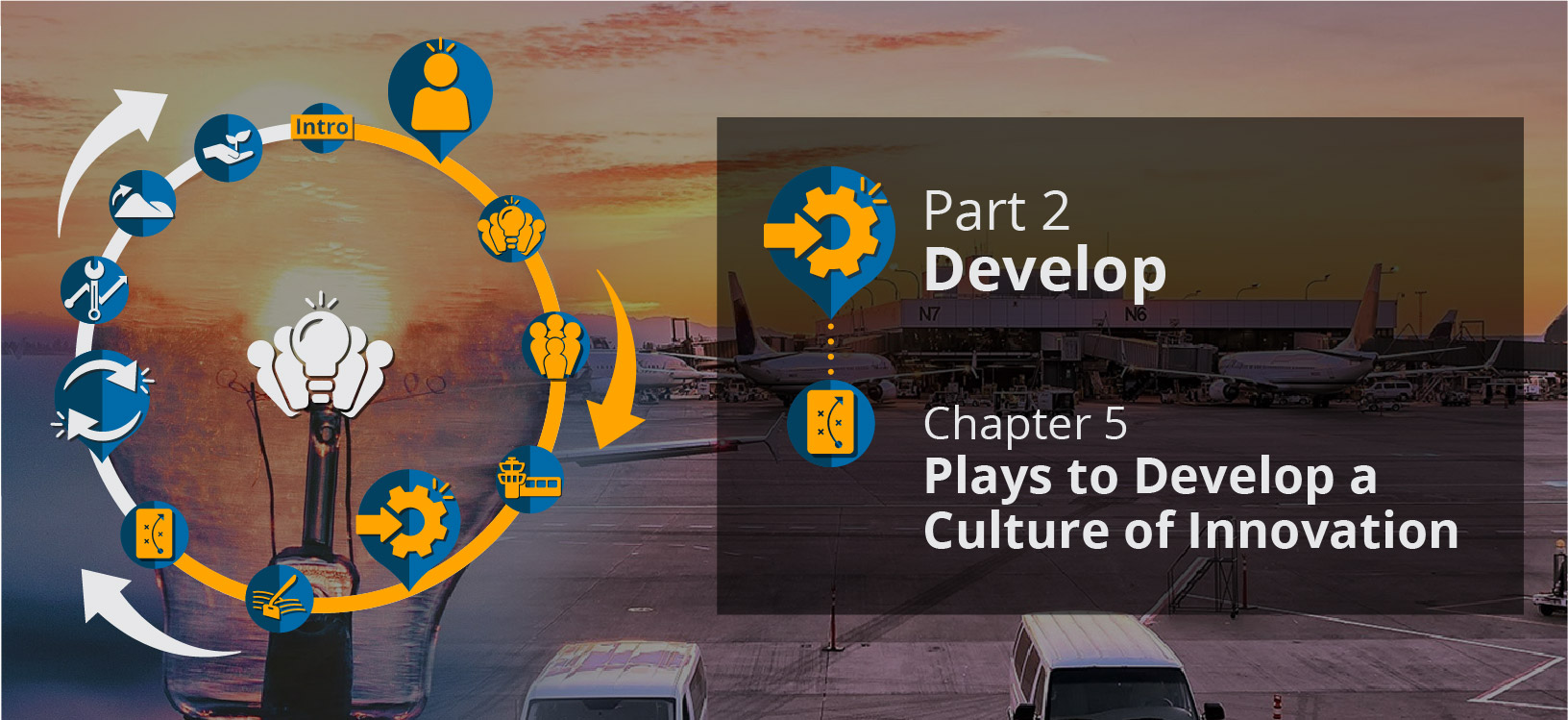

This is a Deep Dive page. Select the chapter for the Fast Track
Play 6: Develop an Innovation Mindset (Staff)
Innovative staff are open to change and constantly striving to try new things. They take calculated risks, analyze results, and share findings to be accountable. They focus on experimenting in increments, collecting feedback from their work and then applying lessons learned from setbacks before trying to experiment again.
Avoiding the Stigma Associated with “Failure”
Innovative staff
- Collaborate and lead by example. Acknowledge that people resist trying new things when they fear failure, and educate others. Also talk openly about it being an unattainable goal for people to do something perfectly on their first try, if ever. Avoid working in isolation and focusing solely on personal achievements; instead, seek out collaborative work relationships that are inspirational, and enable sharing of both progress and setbacks. Become energized by opportunities to transfer knowledge from experimentation efforts. Seek feedback to continuously improve. This process helps staff develop an innovative mindset, as discussed in Chapter 2.
- Replace failure with experimentation. Stop using words like “failure” and instead use those like “experiment” to create an immediate change of perspective related to mistakes, missteps, or unexpected outcomes. Replace the fear of taking a first step with curiosity and an interest in trying something new. Turn problems into opportunities, and minimize risk by reframing results as experiments. Replace the “all or nothing" approach of the former vernacular (e.g., success and failure) with an incremental approach to testing, trying, adjusting, and retesting. All of these office lingo changes can help prime leaders and others to be more comfortable with some levels of acceptable risk and open up the culture to be a little more tolerant of risk.
-
- At the semiconductor company AMD, leaders set up “leapfrog teams” comprised of groups of engineers who simultaneously work on successive generations of core chip designs. The chip undergoes multiple rounds of experiments and modifications, with a focus on knowledge transfer. In the process, teams ensure consistent communication, preserve knowledge, and enforce best practices that can help spur innovation.1
- Focus on the continuous learning cycle. Set the tone in the office by openly communicating about experiments that do not go as anticipated. Help make it a safe environment for everyone to talk about the unexpected as results that need to be analyzed instead of failures that need to be hidden. Demonstrate how people can learn from experiments instead of being shamed for “failed" or “wrong” results. Encourage the sharing of experimental outcomes, and seek input from others to improve upon future results. Continue the experimental cycle until either desired results are achieved or new outcomes take the project in a different direction. Communicate that each attempt increases the probability of an eventual success.
Encourage Open Communication Related to Experimenting
Innovative staff
- Get to know others. Regularly seek out input from diverse staff as various perspectives and outlooks produce more innovative ideas. Keep a pulse on colleagues and actively engage with others in a setting comfortable to them to discuss feelings about a new idea or concept in order to shape how to move forward. Seek opinions in a variety of ways to account for the various personality types and working styles of others. For example, for those who do not like to share ideas in a public format, like a meeting, try having private conversations with them instead. Keep the focus on track by centering the customer at the heart of every idea they contribute to and discuss.
- Bring ideas forward. Be respectful of all ideas brought to the table, as the goal is to create a safe space to share ideas. Be humble by acknowledging and giving credit to others who contribute to ideas.
A Fail-Fast Methodology to Experiment and Document Results
Innovative staff
- Test ideas quickly. Rename the “fail-fast” method to the “experiment-fast” method, and use it to test concepts quickly and apply lessons learned to the next round of activity. Perform experiments that can be scaled quickly so that when ideas do not result in the intended outcomes, they can be either modified and moved forward or retired easily. Be mindful that the experiment-fast method is not a replacement for strategic analysis and planning, so make sure this is done as a secondary step. Remind others that some ideas may not lead to fruitful results and need to be shut down before too much is invested. Use this methodology as a way of trying out a new idea, getting quick feedback on it, and then rapidly inspecting and adapting it to see if it is worth continuing to move forward. As former U.S. Attorney General Robert F. Kennedy said, “Only those who dare to fail greatly, achieve greatly.”2
- Get leaders on board. It is critical to get leadership support for the experiment-fast methodology. Make sure that leadership support demonstrates to everyone that careers, bonuses, and promotions are not at risk if an idea does not go as intended. In fact, the entire culture of an airport must value this type of methodology so that any knowledge gained on an endeavor is communicated and documented for future iterations. For more on this, see Cultivation Cycle in Chapter 4.

1 Laszlo Bock et al., “The 50 Best Workplaces for Innovators,” Fast Company, August 5, 2019, https://www.fastcompany.com/best-workplaces-for-innovators/2019.
2 Robert F. Kennedy, To Seek a Newer World, 1st ed., 87 (Garden City, NY), 1967, https://archive.org/details/toseeknewerworld00kenn.

